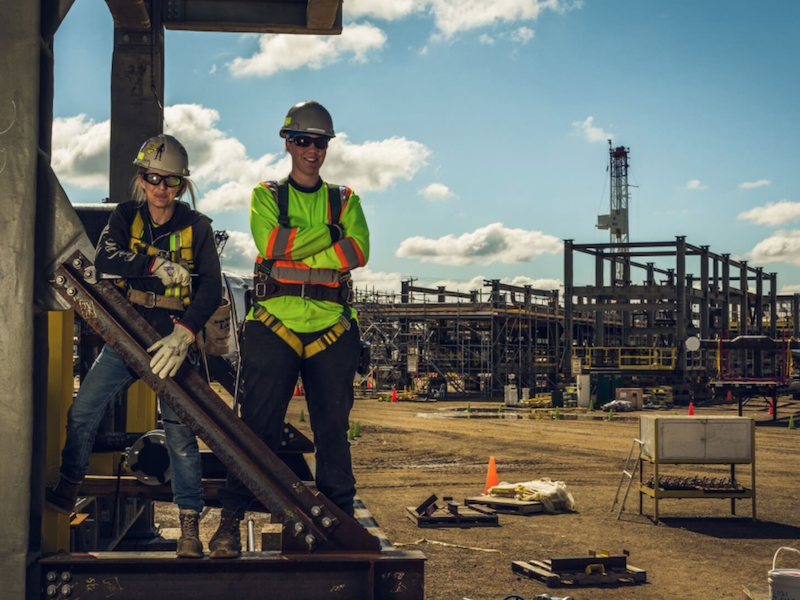
With the majority of PCL Construction Ltd.’s workforce continuing to work at its Canada-wide job sites and offices throughout the coronavirus pandemic, the organization’s decisions around its health benefits and pension plan have been to keep rolling.
Speaking during a Q&A session to close out Benefits Canada‘s 2021 Benefits & Pension Summit on May 19, Mike Olsson, the construction company’s vice-president of human resources and professional development, said about 60 per cent of its 3,000 staff across Canada are on job sites — and considered essential workers — so the ability to work remotely just doesn’t exist. It was the same at the company’s Edmonton corporate office.
“While there was some opportunity to work from home, we saw too big of a loss to operational effectiveness in doing that and, as an essential business, we were actually able to continue to work in the office — our workplaces have completely changed and they changed early,” he said, noting the organization installed plexiglass in offices and mandated masks back in March 2020.
Read: Head to head: Should employers be responsible for personal protective equipment?
“It’s not that we’ve continued to be normal because we haven’t — we’ve done Teams meetings, we jump back and forth. But what that has done in terms of balancing our benefits and pension plans is we’ve kept rolling and kept going. The issue is we’ve had to be way more flexible with our approach . . . Can they work from home? Do they need flex days? How does that look?”
For the benefits and pension plans, it was business as usual, despite a few changes over the past year. “Our decision-making has been a little more hyper-sensitive to the employees and being more employee-centric, what’s right for the employee,” said Olsson.
On the pension side, PCL adapted its plan member communication and education from face-to-face sessions to virtual seminars. It was well-received, he noted, because it was easier for people to tune in. The company is also in the process of changing its pension plan’s investment lineup. The new funds will be added in June, so communication is currently underway, including a series of education sessions.
“We have about $450 million in assets in our plan and we were talking about our fund lineup — so having target-date funds, passive funds and active funds and trying to structure them . . . . We decided to take out six funds and bring in four funds, which will impact $150 million worth of our assets. . . . Fifty per cent of our employees are going to be impacted, at least.”
Read: Target-date funds a game changer for plan member outcomes: research
Also, at the end of March 2020, when the markets were crashing at the onset of the pandemic, PCL’s pension provider sent out education materials on its behalf. The proactive approach helped, said Olsson, noting the organization didn’t see a lot of shifting dollars or fund changes.
In terms of the benefits plan, the company changed its annual enrolment portal provider, its long-term disability provider and doubled its coverage for counselling services over the past 12 months. “We knew mental health was going to be an issue — it is an issue anyway but was enhanced — so we doubled the coverage for the different levels of our plan. And we did not increase employee premiums last year. Even though our costs went up, we said, ‘We are a solid company with a strong foundation, maybe it’s not [75 per cent, 25 per cent] this year, maybe it’s [78 per cent, 22 per cent] and we’ll slowly get back.’”
Despite moving ahead with pension and benefits changes over the past year, the organization did have some tough decisions to make, said Olsson, noting some employees’ jobs changed or became unnecessary during the pandemic. “We created an ability for them to use vacation and then personal leave and different things, even to the point where we changed our roles and we paid for the employee portion of their benefits if it was related to them not being able to work because there was no work.”
And PCL also changed its vacation policy to ensure employees were taking time off. Previously, the organization had allowed staff to carry over 30 days a year. As well, if an employee had 35 days at the end of the year, they could take those five extra days as a payout or put that amount in their pension plan.
Read: U.S. employers tweaking vacation, paid-time-off policies amid pandemic: survey
“During the pandemic, we saw people working extremely hard, not taking vacation, not [taking sick days] — the pressures were mounting and they weren’t taking days off,” said Olsson. “So we challenged our own process . . . and shifted to 15 days from the 30 with no payout. We had to really encourage and push vacation, it was building out long weekends and half days here and there and some staycations. It was marketed as, ‘We need you to take some time off because you’re working too hard and you need to spend time with your families,’ whereas our old school way of thinking before was that vacation was to go on a trip, not just to breathe. So that’s been a massive shift and we felt it was really important.”
